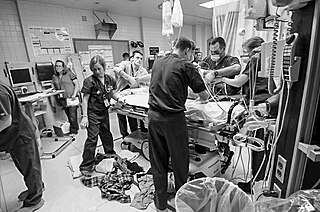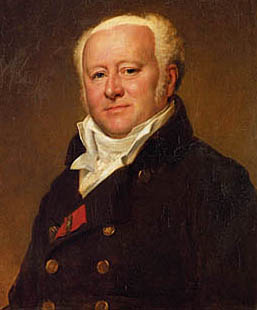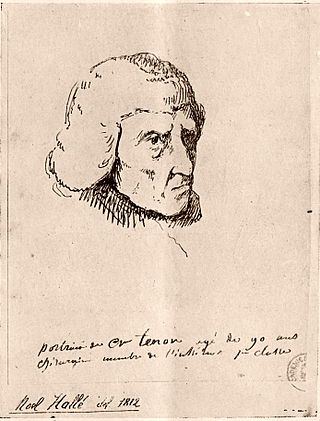Related Research Articles

Medicine is the science and practice of caring for a patient, managing the diagnosis, prognosis, prevention, treatment, palliation of their injury or disease, and promoting their health. Medicine encompasses a variety of health care practices evolved to maintain and restore health by the prevention and treatment of illness. Contemporary medicine applies biomedical sciences, biomedical research, genetics, and medical technology to diagnose, treat, and prevent injury and disease, typically through pharmaceuticals or surgery, but also through therapies as diverse as psychotherapy, external splints and traction, medical devices, biologics, and ionizing radiation, amongst others.

René-Théophile-Hyacinthe Laennec was a French physician and musician. His skill at carving his own wooden flutes led him to invent the stethoscope in 1816, while working at the Hôpital Necker. He pioneered its use in diagnosing various chest conditions. He became a lecturer at the Collège de France in 1822 and professor of medicine in 1823. His final appointments were that of head of the medical clinic at the Hôpital de la Charité and professor at the Collège de France. He went into a coma and subsequently died of tuberculosis on August 13, 1826 at age 45.

In medicine, triage is a process by which care providers such as medical professionals and those with first aid knowledge determine the order of priority for providing treatment to injured individuals and/or inform the rationing of limited supplies so that they go to those who can most benefit from it. Triage is usually relied upon when there are more injured individuals than available care providers, or when there are more injured individuals than supplies to treat them.

Emergency medicine is the medical speciality concerned with the care of illnesses or injuries requiring immediate medical attention. Emergency physicians specialize in providing care for unscheduled and undifferentiated patients of all ages. As first-line providers, in coordination with emergency medical services, they are primarily responsible for initiating resuscitation and stabilization and performing the initial investigations and interventions necessary to diagnose and treat illnesses or injuries in the acute phase. Emergency medical physicians generally practice in hospital emergency departments, pre-hospital settings via emergency medical services, and intensive care units. Still, they may also work in primary care settings such as urgent care clinics.

An emergency department (ED), also known as an accident and emergency department (A&E), emergency room (ER), emergency ward (EW) or casualty department, is a medical treatment facility specializing in emergency medicine, the acute care of patients who present without prior appointment; either by their own means or by that of an ambulance. The emergency department is usually found in a hospital or other primary care center.

In the Middle Ages, the medicine of Western Europe was composed of a mixture of existing ideas from antiquity. In the Early Middle Ages, following the fall of the Western Roman Empire, standard medical knowledge was based chiefly upon surviving Greek and Roman texts, preserved in monasteries and elsewhere. Medieval medicine is widely misunderstood, thought of as a uniform attitude composed of placing hopes in the church and God to heal all sicknesses, while sickness itself exists as a product of destiny, sin, and astral influences as physical causes. On the other hand, medieval medicine, especially in the second half of the medieval period, became a formal body of theoretical knowledge and was institutionalized in the universities. Medieval medicine attributed illnesses, and disease, not to sinful behaviour, but to natural causes, and sin was connected to illness only in a more general sense of the view that disease manifested in humanity as a result of its fallen state from God. Medieval medicine also recognized that illnesses spread from person to person, that certain lifestyles may cause ill health, and some people have a greater predisposition towards bad health than others.

Jean-Nicolas Corvisart-Desmarets was a French physician.

Joseph Škoda was an Austrian physician, medical professor and dermatologist. Together with Carl Freiherr von Rokitansky, he was the founder of the Modern Medical School of Vienna.

Byzantine medicine encompasses the common medical practices of the Byzantine Empire from c. 400 AD to 1453 AD. Byzantine medicine was notable for building upon the knowledge base developed by its Greco-Roman predecessors. In preserving medical practices from antiquity, Byzantine medicine influenced Islamic medicine and fostered the Western rebirth of medicine during the Renaissance.

Hôpital de la Charité was a hospital in Paris founded by the Brothers Hospitallers of St. John of God in the 17th century. In 1935, it was closed and demolished to make way for the new faculty of medicine. Located at 45, rue des Saints-Pères, the premises currently house the Centre Universitaire des Saints-Pères, one of the sites of the University of Paris-Descartes.
The most common mode of healthcare delivery is through personal, face-to-face contact between a healthcare provider and a beneficiary (patient). There is, however, an increasing trend towards the provision of healthcare in the absence of personal contact. This limit of contact during patient care is known as in absentia health care.

The Hôtel-Dieu is a public hospital located on the Île de la Cité in the 4th arrondissement of Paris, on the parvis of Notre-Dame. Tradition has it that the hospital was founded by Saint Landry in 651 AD, but the first official records date it to 829, making it the oldest in France and possibly the oldest continuously operating hospital in the world. The Hôtel-Dieu was the only hospital in the city until the beginning of the 17th century.

Medicine in ancient Rome was highly influenced by ancient Greek medicine, but also developed new practices through knowledge of the Hippocratic Corpus combined with use of the treatment of diet, regimen, along with surgical procedures. This was most notably seen through the works of two of the prominent Greek physicians, Dioscorides and Galen, who practiced medicine and recorded their discoveries. This is contrary to two other physicians like Soranus of Ephesus and Asclepiades of Bithynia, who practiced medicine both in outside territories and in ancient Roman territory, subsequently. Dioscorides was a Roman army physician, Soranus was a representative for the Methodic school of medicine, Galen performed public demonstrations, and Asclepiades was a leading Roman physician. These four physicians all had knowledge of medicine, ailments, and treatments that were healing, long lasting and influential to human history.
The doctor–patient relationship is a central part of health care and the practice of medicine. A doctor–patient relationship is formed when a doctor attends to a patient's medical needs and is usually through consent. This relationship is built on trust, respect, communication, and a common understanding of both the doctor and patients' sides. The trust aspect of this relationship goes is mutual: the doctor trusts the patient to reveal any information that may be relevant to the case, and in turn, the patient trusts the doctor to respect their privacy and not disclose this information to outside parties.

Jacques-René Tenon was a French surgeon born in Sépeaux in northern Burgundy. He was very active in hospital reform during the second half of the 18th century. His seminal treatise on hospital design and management, the Mémoire sur les hôpitaux de Paris, proved to be influential in Europe for more than a century.

The Necker–Enfants Malades Hospital is a French teaching hospital in the 15th arrondissement of Paris. It is a hospital of the Assistance Publique – Hôpitaux de Paris group and is affiliated to the Université Paris Cité. Necker–Enfants Malades Hospital was created in 1920 by the merger of Necker Hospital, which was founded in 1778 by Suzanne Necker, with the physically contiguous Sick Children's Hospital, the oldest children's hospital in the Western world, founded in 1801.
The history of hospitals began in antiquity with hospitals in Greece, the Roman Empire and on the Indian subcontinent as well, starting with precursors in the Asclepian temples in ancient Greece and then the military hospitals in ancient Rome. The Greek temples were dedicated to the sick and infirm but did not look anything like modern hospitals. The Romans did not have dedicated, public hospitals. Public hospitals, per se, did not exist until the Christian period. Towards the end of the 4th century, the "second medical revolution" took place with the founding of the first Christian hospital in the eastern Byzantine Empire by Basil of Caesarea, and within a few decades, such hospitals had become ubiquitous in Byzantine society. The hospital would undergo development and progress throughout Byzantine, medieval European and Islamic societies from the 5th to the 15th century. European exploration brought hospitals to colonies in North America, Africa, and Asia. St Bartholomew's hospital in West Smithfield in London, founded in 1123, is widely considered the oldest functioning hospital today. Originally a charitable institution, currently an NHS hospital it continues to provide free care to Londoners, as it has for 900 years. In contrast, the Mihintale Hospital in Sri Lanka, established in the 9th century is probably the site with the oldest archaeological evidence available for a hospital in the world. Serving monks and the local community, it represents early advancements in healthcare practices.

The Catholic Church is the largest non-government provider of health care services in the world. It has around 18,000 clinics, 16,000 homes for the elderly and those with special needs, and 5,500 hospitals, with 65 percent of them located in developing countries. In 2010, the Church's Pontifical Council for the Pastoral Care of Health Care Workers said that the Church manages 26% of the world's health care facilities. The Church's involvement in health care has ancient origins.
The Law of 1794, derived from the Fourcroy Report of 1794, was enacted by the National Convention in December, 1794 in Paris, France. The law, stemming from a report from Antoine François, comte de Fourcroy, proposed the reorganization of the structure of medical education in post-revolution France and sought to lay the ground work for the institution of Hospital Medicine in France.

A teaching hospital is a hospital or medical center that provides medical education and training to future and current health professionals. Teaching hospitals are almost always affiliated with one or more universities and are often co-located with medical schools.
References
- ↑ Ferngren, Gary (2009). Medicine and Health Care in Early Christianity. Baltimore. pp. 124–30.
{{cite book}}: CS1 maint: location missing publisher (link) - ↑ Henderson, John (2006). Renaissance Hospital, Healing the Body and Healing the Soul. Yale University Press. p. 458. ISBN 0300109954.
- 1 2 3 Lindemann, Mary (2010). Medicine and Society in Early Modern Europe. Cambridge University Press.
- ↑ Cunningham, Andrew (1997). Health Care and Poor Relief in Protestant Europe 1500-1700. London and New York.
{{cite book}}: CS1 maint: location missing publisher (link) - 1 2 3 Risse, Guenter (1999). Mending Bodies, Saving Souls: A History of Hospitals. New York: Oxford University Press.
- ↑ Weiner, Dora B.; Sauter, Michael J. (2003-01-01). "The City of Paris and the Rise of Clinical Medicine". Osiris. 18: 23–42. doi:10.1086/649375. JSTOR 3655283. PMID 12964569. S2CID 10692225.
- 1 2 3 4 5 Risse, Guenter B. (1999-04-15). Mending bodies, saving souls : a history of hospitals / monograph. Oxford University Press. ISBN 0195055233. OCLC 862148135.
- ↑ Ossola, Alexandra (August 25, 2010). "Revolutionary Medicine and the Medical Revolution". Hamilton University. Retrieved 10 March 2017.
- ↑ Wellman, Kathleen (1996-01-01). "Review of The Citizen-Patient in Revolutionary and Imperial Paris". The Journal of Modern History. 68 (1): 195–197. doi:10.1086/245307. JSTOR 2124354.
- ↑ Ackerknecht, Erwin Heinz (1967-01-10). Medicine at the Paris hospital, 1794-1848.
- 1 2 3 4 5 Weiner, Dora; Sauter, Michael (2003). "The City of Paris and the Rise of Clinical Medicine". Osiris. 2nd Series. 18: 23–42. doi:10.1086/649375. JSTOR 3655283. PMID 12964569. S2CID 10692225.
- ↑ Risse, Guenter (1999). Mending Bodies, Saving Souls: A History of Hospitals. Oxford University Press.
- ↑ Weiner, Dora B. (1991). "Triage for health care in a metropolis: Paris under Napoleon". Med Secoli. 3 (2–3): 175–190. PMID 11640120.
- ↑ Mercier, Louis-Sébastien (1783–89). Tableau de Paris, Nouv. éd. corrigée & augmentée. Amsterdam.
- ↑ Farrell, Gabriel (1956). The Story of Blindness. Harvard University Press. ISBN 9780674333536.
- ↑ "The long shadow of colonial medicine". www.aeaweb.org. Retrieved 2021-04-09.
- ↑ Lowes, Sara; Montero, Eduardo (2021). "The Legacy of Colonial Medicine in Central Africa". American Economic Review. 111 (4): 1284–1314. doi: 10.1257/aer.20180284 . ISSN 0002-8282.